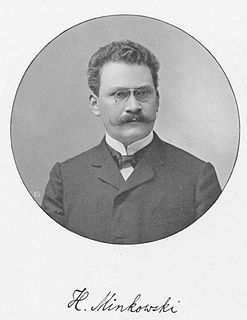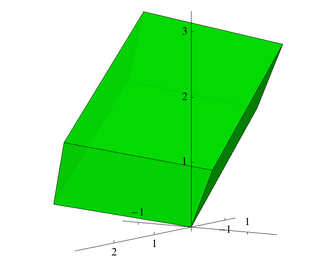
In mathematics, a field is a set on which addition, subtraction, multiplication, and division are defined, and behave as the corresponding operations on rational and real numbers do. A field is thus a fundamental algebraic structure, which is widely used in algebra, number theory and many other areas of mathematics.

In mathematics, a ring is one of the fundamental algebraic structures used in abstract algebra. It consists of a set equipped with two binary operations that generalize the arithmetic operations of addition and multiplication. Through this generalization, theorems from arithmetic are extended to non-numerical objects such as polynomials, series, matrices and functions.
In number theory, the ideal class group of an algebraic number field K is the quotient group JK/PK where JK is the group of fractional ideals of the ring of integers of K, and PK is its subgroup of principal ideals. The class group is a measure of the extent to which unique factorization fails in the ring of integers of K. The order of the group, which is finite, is called the class number of K.
In mathematics, an algebra over a field is a vector space equipped with a bilinear product. Thus, an algebra is an algebraic structure, which consists of a set, together with operations of multiplication, addition, and scalar multiplication by elements of the underlying field, and satisfies the axioms implied by "vector space" and "bilinear".

The Poincaré group, named after Henri Poincaré (1906), was first defined by Minkowski (1908) as the group of Minkowski spacetime isometries. It is a ten-dimensional non-abelian Lie group of fundamental importance in physics.

In mathematical physics, Minkowski space is a combination of three-dimensional Euclidean space and time into a four-dimensional manifold where the spacetime interval between any two events is independent of the inertial frame of reference in which they are recorded. Although initially developed by mathematician Hermann Minkowski for Maxwell's equations of electromagnetism, the mathematical structure of Minkowski spacetime was shown to be an immediate consequence of the postulates of special relativity.
In mathematics, a global field is a field that is either:
In mathematics, Dirichlet's unit theorem is a basic result in algebraic number theory due to Peter Gustav Lejeune Dirichlet. It determines the rank of the group of units in the ring OK of algebraic integers of a number field K. The regulator is a positive real number that determines how "dense" the units are.
In mathematics, a Galois module is a G-module, with G being the Galois group of some extension of fields. The term Galois representation is frequently used when the G-module is a vector space over a field or a free module over a ring, but can also be used as a synonym for G-module. The study of Galois modules for extensions of local or global fields is an important tool in number theory.
The Artin reciprocity law, which was established by Emil Artin in a series of papers, is a general theorem in number theory that forms a central part of global class field theory. The term "reciprocity law" refers to a long line of more concrete number theoretic statements which it generalized, from the quadratic reciprocity law and the reciprocity laws of Eisenstein and Kummer to Hilbert's product formula for the norm symbol. Artin's result provided a partial solution to Hilbert's ninth problem.

In mathematics, the discriminant of an algebraic number field is a numerical invariant that, loosely speaking, measures the size of the algebraic number field. More specifically, it is proportional to the squared volume of the fundamental domain of the ring of integers, and it regulates which primes are ramified.
In mathematics, the Hilbert symbol or norm-residue symbol is a function from K× × K× to the group of nth roots of unity in a local field K such as the fields of reals or p-adic numbers. It is related to reciprocity laws, and can be defined in terms of the Artin symbol of local class field theory. The Hilbert symbol was introduced by David Hilbert in his Zahlbericht, with the slight difference that he defined it for elements of global fields rather than for the larger local fields.
In mathematics, field arithmetic is a subject that studies the interrelations between arithmetic properties of a field and its absolute Galois group. It is an interdisciplinary subject as it uses tools from algebraic number theory, arithmetic geometry, algebraic geometry, model theory, the theory of finite groups and of profinite groups.
In mathematics, in the field of algebraic number theory, a modulus is a formal product of places of a global field. It is used to encode ramification data for abelian extensions of a global field.
In algebraic number theory, the conductor of a finite abelian extension of local or global fields provides a quantitative measure of the ramification in the extension. The definition of the conductor is related to the Artin map.
In mathematics, an algebraic number fieldF is a finite degree field extension of the field of rational numbers Q. Thus F is a field that contains Q and has finite dimension when considered as a vector space over Q.
In mathematics, Shintani's unit theorem introduced by Shintani is a refinement of Dirichlet's unit theorem and states that a subgroup of finite index of the totally positive units of a number field has a fundamental domain given by a rational polyhedric cone in the Minkowski space of the field.
In mathematics, especially in algebraic number theory, the Hermite–Minkowski theorem states that for any integer N there are only finitely many number fields, i.e., finite field extensions K of the rational numbers Q, such that the discriminant of K/Q is at most N. The theorem is named after Charles Hermite and Hermann Minkowski.









